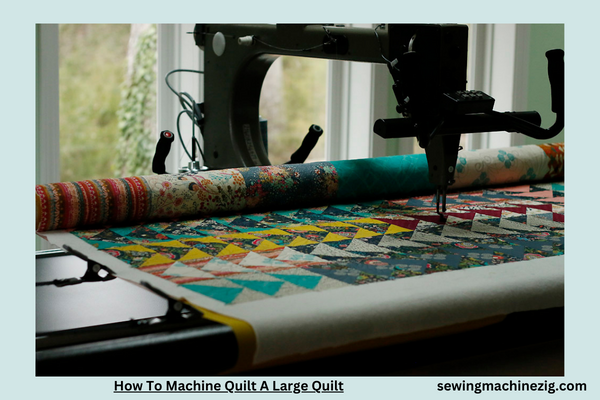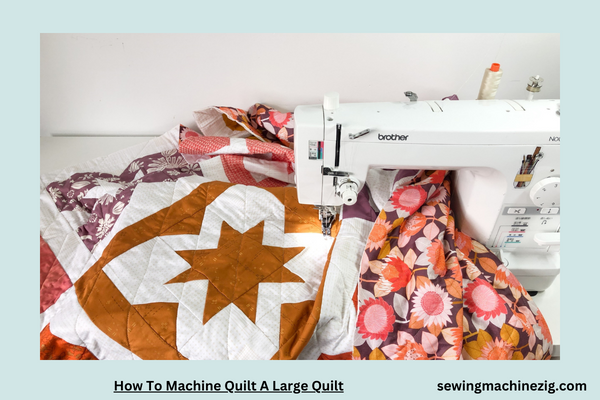
Machine quilting a large quilt can be a daunting task, but with the right techniques and guidance, it becomes a manageable and rewarding project. The art of “how to machine quilt a large quilt” is a skill that allows you to add your unique touch to your quilting projects, offering both creativity and functionality.
Thank you for reading this post, don't forget to subscribe!Whether you’re an experienced quilter or a novice looking to take on a larger project, this guide will provide you with step-by-step instructions and tips to navigate the process effectively. Say goodbye to the intimidation factor and hello to beautiful, machine-quilted large quilts.
How To Machine Quilt A Large Quilt Detailed Answer

Machine quilting a large quilt is a rewarding and creative process, allowing you to transform your fabric into a work of art. In this extensive guide on “how to machine quilt a large quilt,” we will provide detailed step-by-step instructions, helping you master the art of machine quilting, whether you’re a seasoned quilter or a novice looking to take on a larger project.
Step 1: Prepare Your Workspace
Begin by setting up a spacious, well-lit workspace. Ensure you have a flat and sturdy surface that can accommodate the size of your large quilt. Clear any obstructions and clean your workspace to create an ideal quilting environment.
Step 2: Gather Your Materials
Before you begin quilting, gather all the materials and tools you’ll need. These include your large quilt top, suitable batting, backing fabric, quilting thread in a color that complements your design, quilting safety pins, or basting spray.
Step 3: Layer the Quilt Sandwich
Lay your backing fabric on your work surface, wrong side up. Smooth it out, eliminating any wrinkles or bumps, and secure it in place using painter’s tape or a similar adhesive that won’t damage the fabric. Next, place the batting on top of the backing fabric. Carefully center your quilt top, right side up, on the batting, ensuring it lies flat and wrinkle-free.
Step 4: Pin or Baste the Layers
To prevent the layers from shifting during machine quilting, secure them together. You can use quilting safety pins placed a few inches apart or opt for basting spray, which provides a temporary adhesive hold.
Step 5: Set Up Your Sewing Machine
Prepare your sewing machine for quilting. Install a walking foot, which helps feed all layers evenly, reducing the risk of puckering. Choose a quilting needle suitable for the thickness of your quilt. Fill your bobbin with the quilting thread that matches your design and top thread.
Step 6: Choose Your Quilting Design
Select the quilting design that best complements your large quilt. Common options include straight-line quilting, free-motion quilting, or using a quilting template. Lightly mark your quilting lines on the quilt top using a fabric pen or tailor’s chalk.
Step 7: Start Quilting
Begin quilting in the center of the quilt and work your way outward toward the edges. Start stitching along your marked lines, following your chosen quilting design. Keep a slow, steady pace to maintain even stitches and a consistent stitch length. You can pivot or stop and reposition the quilt as needed to ensure accuracy.
Step 8: Check Tension and Thread
Periodically check the tension of your quilting thread to ensure it’s consistent. Balanced thread tension is crucial for achieving even, well-defined stitches on both sides of the quilt. Adjust your machine’s tension settings if necessary.
Step 9: Take Breaks
Machine quilting a large quilt can be physically demanding, so take short breaks to prevent fatigue and maintain precise stitching. Use these breaks to inspect your work, check for any skipped stitches, and make any necessary adjustments.
Step 10: Finish the Central Area
Once you’ve quilted the central area of your large quilt, pay attention to the outer edges. Make sure all layers are securely quilted to prevent shifting or bunching. This is particularly important on larger quilts, where the weight of the fabric can lead to uneven tension.
Step 11: Trim and Bind
After completing the quilting process, trim any excess batting and backing fabric from the edges. Finally, add binding to the quilt to give it a clean, finished appearance. Binding not only adds a professional touch but also secures the quilt’s edges.
Mastering the art of machine quilting a large quilt can be an immensely satisfying and creative experience. By following this detailed step-by-step guide, how to machine quilt a large quilt you’ll be well-equipped to tackle even the most extensive quilting projects. With patience and practice, you’ll create a magnificent large quilt that reflects your artistry and dedication to the craft.
Conclusion
Mastering “how to machine quilt a large quilt” opens up a world of creative possibilities in the realm of quilting. With patience, practice, and attention to detail, you can confidently embark on even the most substantial quilting projects.
The satisfaction of completing a large quilt that reflects your unique style and craftsmanship is immeasurable. So, whether you’re quilting for artistic expression, warmth, or gifting, this guide provides the comprehensive steps and insights needed to bring your quilting vision to life on a grand scale.”how to machine quilt a large quilt“
FAQS
Q1: What’s the significance of machine quilting over hand quilting for a large quilt?
A1: Machine quilting is often preferred for large quilts due to its efficiency. It allows for faster quilting and is especially beneficial when dealing with extensive projects like large quilts.
Q2: Can I use any sewing machine for quilting a large quilt?
A2: Most sewing machines can be used for quilting, but a machine with a walking foot or quilting foot is ideal for larger projects. These feet help feed the layers evenly and prevent puckering.
Q3: How do I choose the right quilting design for a large quilt?
A3: The choice of quilting design largely depends on your personal style and the quilt’s purpose. For large quilts, simple and bold designs like straight-line quilting or large-scale patterns often work well.
Q4: What’s the best way to handle the weight and bulk of a large quilt while quilting on a home sewing machine?
A4: To manage the weight and bulk, use a large table or extension to support the quilt’s surface. Rolling or folding the quilt as you work on one section at a time can also make the process more manageable.
Q5: Can I quilt a large quilt using a domestic sewing machine with a smaller throat space?
A5: Yes, you can quilt a large quilt on a machine with a smaller throat space, but it may require more rolling or folding to fit the quilt through. Alternatively, you can seek professional long-arm quilting services for such projects.“how to machine quilt a large quilt“
Q6: How do I prevent fabric puckering when quilting a large quilt on a sewing machine?
A6: To prevent puckering, ensure you’re using the appropriate needle and thread for quilting. Maintain even tension on both the top and bobbin threads, and practice even stitching with a consistent stitch length.



